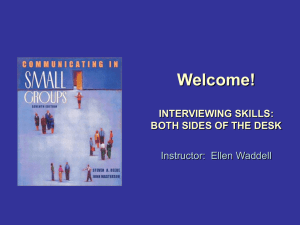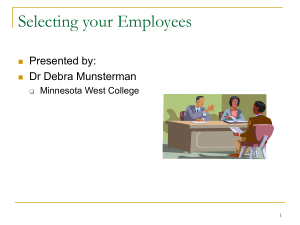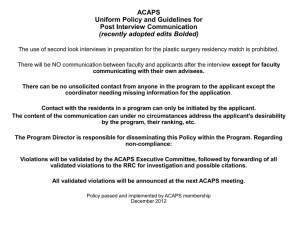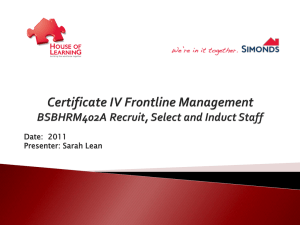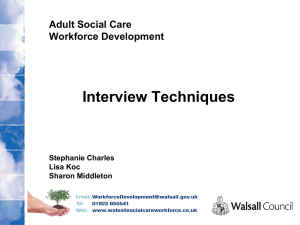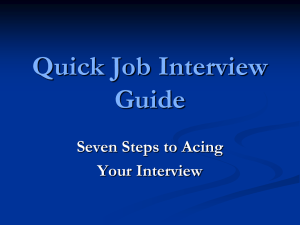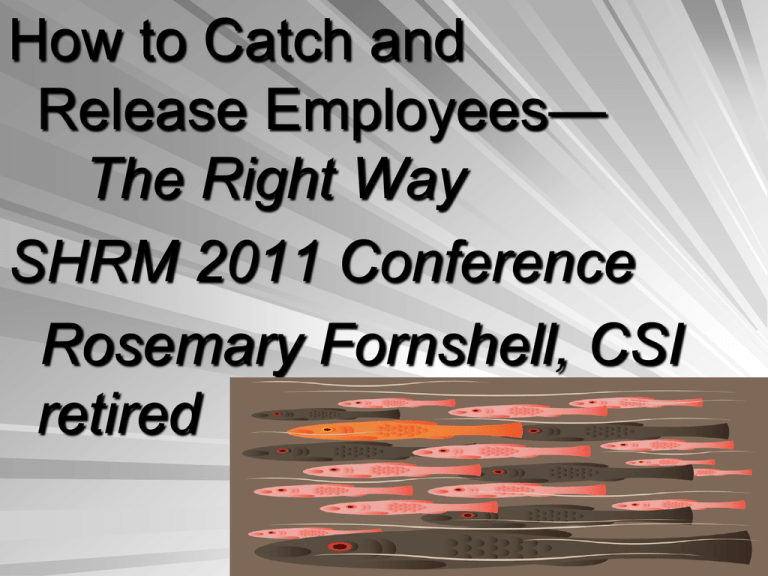
How to Catch and
Release Employees—
The Right Way
SHRM 2011 Conference
Rosemary Fornshell, CSI
retired
THE CATCH:
The Hiring Process
Practical Skills for Human
Resource Professionals
HR Mission Statement
The Mission of the Human Resources
Department is to Recruit, Develop, and
Retain the High-Caliber, Diverse
Workforce Necessary for your Business to
Achieve Its Mission And Goals.
Quality Candidates
Defined Position
Critical Competencies
Job Analysis
Training and development
Valid Assessment: Improved job/person match
Realistic Job Preview
Defining Today’s Jobs
OLD
New
Knowledge, skills,
abilities
Jobs defined as
“bundles of tasks”
Employees perform
strictly definable tasks
Competencies
Jobs defined by
competencies
Jobs are flexible
Keys to Success
Up-to Date Classification Criteria
Job Related Qualifications
Targeted Recruitment
Valid Assessment
Resumes from?
Response to Ads
Career Builders Web Site
Internal Transfer Request
Career Fairs
Other?
Lacks Skills to do the job
Not team Player
Problems with co/workers
Not my job syndrome
Bad Hire
Un-Professional
Part of the problem
Not the solution
Able & Suitable
Manageability
&
Teamwork
Willingness
Ideal Candidate
Professional
Behavior & Demeanor
Problem Solving
Abilities
Personal Profile
Drive: A desire to get things done. Goal-Oriented.
Motivation: Enthusiasm and willingness to ask questions.
Does extra on every job.
Communication skills: The ability to talk and write
effectively to people at all levels.
Chemistry: Gets along with others, A team player.
Energy: Someone who goes the extra mile, pays
attention to detail, looks for solutions.
Determination: Does not quit when a problem gets
tough.
Confidence: Not arrogant. Poise. Friendly, honest and
open to employees high and low. Not intimidated by
management, nor overly familiar.
Professional Profile
Reliability: Following up, not relying on anyone else to ensure the
job is well done, keeps management informed.
Honesty/Integrity: Taking responsibility for own actions, Good and
bad.
Pride: Pays attention to details all jobs done to best of their ability.
Dedication: Whatever it takes in time and effort to see a project
through to completion.
Analytical Skills: Weighing the pros and cons. Weighing the shortand long term benefits against all possible negatives.
Listening Skills: Listening and understanding, as opposed to waiting
your turn to speak.
Structured Interview
Contains interview questions for both
general and technical competencies.
Modular format; Department determines
which questions to ask.
Benchmarks are used in scoring
responses.
Goals of Structured Interview
To ensure a systematic coverage of
applicants.
To provide a technique for gathering all
the relevant facts.
To provide a uniform strategy that
objectively evaluates all job candidates.
To determine candidates ability,
willingness, and manageability.
What are the five most important
skills of the job?
The Job description
Skill 1
Skill 2
Skill 3
Skill 4
Skill 5
Develop questions covering each
area
Interview Questions
Skill 1
Skill 2
Skill 3
Skill 4
Skill 5
Ways not to conduct an interview
Interviewers desk is cluttered, looks at the
resume 5 minutes before the interview.
Constant interruptions, phone calls
Starts off with negative aspects of the job.
Asks a long line of open ended questions.
Makes up questions as they go along.
The Job Interview Situation
Have as much privacy as possible
Call applicant by name when inviting them into
the office
Ensure that the applicant knows your name
Greet the applicant courteously and sincerely
Make the applicant feel that you are pleased
with their interest in the position
Establish an informal but business like
atmosphere
Make the applicant feel important
Talk to the applicant as though you were
the only contact he would ever have with
the employer
Compliment a good employment record
Interrupt the conversation to keep
interview on track
Use active listening skills
Relax and the applicant will relax
Keep information given, confidential
Remember the applicants time is valuable
Watch for gaps in work record
Use application blanks and other data in
planning the interview
Make an outline in advance, of the main
items of information you want to obtain
during the interview
Plan the time required for interview
Don’ts
Interview when worried, upset, ill or under
stress
Hold the interview in a noisy place
Keep applicants waiting unnecessarily
Give the impression of being abrupt or
harsh
Allow outside interruptions
Seek information you already have
Antagonize the applicant
Show emotion at any physical handicap
Hurt the applicant’s feelings or destroy his
faith in himself
Forget that the applicant is sensitive to
every word the interviewer speaks
Appear to loose interest in the interview
Pry into personal lives
Break or delay an appointment
Waste time on a long interview if the
applicant is clearly not suitable
The Interview
Greet the applicant. Start the interview promptly. Open
with a warm, genuine greeting and firm handshake. Offer
the applicant something to drink.
Outline the interview. Give the applicant an overview of
the process, length of the interview and what to expect
after the interview.
Give the applicant a realistic job preview. Research
suggest that realistic job previews increase employee
retention because the applicant gets honest information
at the beginning of the process.
Present the applicant with a copy of the job description,
physical requirements of the job and a list of the
responsibilities of the position.
Equal Employment Opportunity
Laws
Title VII of the Civil Rights Act of 1964 (Title VII) forbids
employment discrimination based on race, color, religion,
sex, or national origin;
The Equal Pay Act of 1963 (EPA) protects men and
women who perform substantially equal work in the
same establishment from sex-based wage discrimination.
The Age Discrimination in Employment Act of 1967
(ADEA) protects individuals who are 40 years of age or
older against age based discrimination.
Title I of the Americans with Disabilities Act of 1990
(ADA) forbids employment discrimination against
qualified individuals with disabilities.
The Civil Rights Act of 1991 provides monetary damages
in cases of intentional employment discrimination.
Questions that are illegal
Questions regarding religion, church,
synagogue, or parish, the religious
holidays you observe, political beliefs or
affiliations.
“Does your religion allow you to work on
Saturdays?”
If Job Requirement May Ask
“This job requires work on Saturdays. Is
that a problem?”
Questions that are illegal
Regarding ancestry, national origin, or
parentage; in addition, you cannot ask
about the naturalization status of parents,
spouse or children.
Regarding place of birth.
May Ask
“Are you authorized to work in the United
States?”
Questions that are illegal
May not ask about your native language,
the language you speak at home, or how
you acquired the ability to read, write, or
speak a foreign language.
“You indicated on your resume you are
fluent in German, French and Spanish.
How did you manage to learn all of those
languages?”
If required for the Job may ask
“What languages are you fluent in”
Questions that are illegal
May not ask about age, date of birth, or
the ages of children.
May ask whether you are over eighteen
years of age.
Questions that are illegal
May not ask about maiden names or
whether you have changed your name;
marital status, number of children or
dependents, or spouse’s occupation; or
whether (if you are a woman) you wish to
be addressed as Miss., Mrs., or Ms.
May ask
How would you like to be addressed (a
common courtesy) and if you have worked
for the employer before under a different
name.
Questionable Interview Questions
In a scene from the first episode of The
Mary Tyler Moore Show, Lou Grant is
interviewing Mary for a job.
Lou: So, Mary, what religion are you?
Mary: You can’t ask me that, Mr. Grant!
It’s against the law.
Lou: Wanna call a cop?
Pitfalls to Avoid
In order to gain information without asking
specific questions, many interviewers use
the “tell me about yourself” approach,
hoping that the applicant will tell all about
spouse, kids, working on weekends, and
so on.
Dangers of this approach
Say the applicant is a woman who tells the
interviewer she is divorced and has children.
Another person is hired—perhaps equally
qualified who is single.
The first applicant, desperate for the job,
becomes angry and files a complaint saying that
the employer learned during the interview that
she was divorced and had children and was not
hired for that reason.
Even though the interviewer did not ask for
the information, the fact is, the information
came to light during the interview.
If she files suit, it is then up to the
employer to prove that the information was
volunteered and not used as a basis of
discriminatory actions,
It is the interviewer’s responsibility and in
the employer ‘s best interest that you stop
the applicant from volunteering illegal
information.
What to do when illegal information
is out
First, stop the flow of information and tell
the applicant not to bring up the subject
again.
Courteously explain that the employer
does not base its hiring practices on that
particular subject area.
Specifically state that a decision to hire is
never based on age, gender, race, or
whatever subject was brought up.
Don’t assume…ask specifics
“We are open to the public from 8:00 a.m. to 5:00 p.m.,
and because of a small staff, it’s important that everyone
be here daily and on time. Is there anything that would
prevent you from being at work on time and on a regular
basis?“
“We feel that the first six months on the job is your
training period. Because of the expense and time
invested in our staff we are looking for people who give
the employer a commitment in return. Is there anything
that would prevent you from staying with the employer
for a minimum of two years?”
Caution
Be sure the requirements are reasonable and
required of each applicant for the particular job.
If a job takes one to two weeks of training, and
the typical employee rarely stays over six
months, we could be on shaky ground with the
EEOC if your excuse for not hiring someone was
the expectation tat they would be transferred
with a spouse within a year, particularly a
spouse in the military service.
General Rule
Ask everyone the same, job-related
questions and you’ll have little to fear if a
rejected candidate has a legal bone to pick
with your hiring practices.
…And ReleaseLetting Employees Go
“Hire slowly, fire quickly”
Performance Problems
What’s the cause of the performance
problem?
– skill, motivation, ability, obstacles
What’s the appropriate solution?
– training
– job design
– rewards
– transfer
– termination
Modifying Behavior
Identify behavior you want to
stop/encourage
Analyze reinforcers
Identify obstacles to desired behavior
Clarify performance expectations
Obtain agreement
Follow-up and:
– Coach continuing problems
– Reinforce correct behavior
Progressive Discipline
Investigate and document problem
Oral warning
Written warning
Suspension (or final warning)
– <optional: Termination hearing>
Termination
Severe infractions lead directly to termination
Fear of Firing
Terminations are the single largest reason
for employee lawsuits. Why?
Fear of a wrongful discharge suit
paralyzes some employers
Don’t employers have a right to employ
who they want?
Employment at Will Doctrine
Employer may terminate employment for
good reason, poor reason, or no reason at
all
– except discrimination on protected characteristics or
retaliation for exercising legal rights
Employee has the same right
60-65% of employees fall in this category
Employment at Will: Exceptions
Breach of contract
– Collective bargaining agreements
– Literal or Implied contracts
Duty of good faith/fair dealing
Public policy
– Refusing to violate law
– Retaliation
Fairness in Firing
Ultimate issue: Will your decision be
judged to be fair?
– To the employee affected
– To coworkers
– To a jury (or arbitrator)
Why Terminate Employees?
For Cause
– What about off-the-job behavior?
Reductions in force
Alternatives to Termination
Transfer
Restructure
Neutralize
Encouraging employee to resign
Transfers
When appropriate?
– Employee has valuable skills that can be
applied elsewhere
– Performance problems won’t affect new
position
– Easier in larger and “richer” firms
New supervisor should be fully appraised
Restructuring
Same basic guidelines as for transfers
More likely in good times and labor
shortages
Employee involvement particularly
important
Neutralizing
When you want to fire…. but can’t
Restructuring work so negatives have
least impact on you, coworkers or
customers
– Ensuring that employee “is no longer in the
way of employees who are productive for the
company”
What About Encouraging
Employee to Resign?
Can be useful if employee voluntarily quits
because they realize their behavior won’t
be tolerated
But beware of constructive discharge
Firing Summary-I
What warrants termination?
– Chronic Performance Problems
– Absenteeism
– Dishonesty
– Insubordination
– Substance abuse?
Firing Summary-II
Clarify employment at will
– Disclaimers in hiring process
– Check/revise policy manual
Avoid appearance of wrongful discharge
– Base decision on business issues
– Use progressive discipline
– Be consistent
Something to remember..
Know when to get yourself into an
organization, and when to take yourself
out…if you don’t, someone will do it to
you.
– Peter Drucker
Sources
University of Texas Human Resources
Legal Issues In Human Resources from
Slideshare.net


